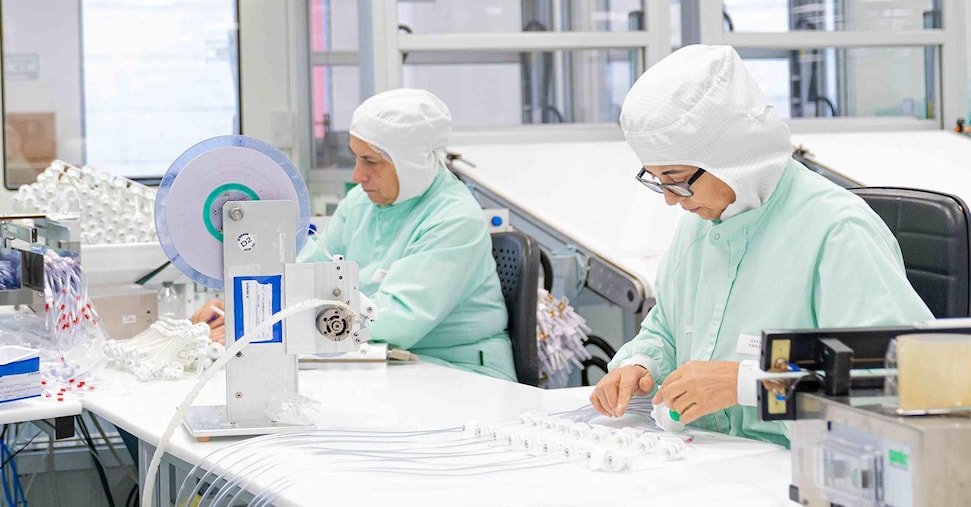Listen to the audio version of the article
It is the first European project that aims to define the guidelines and models for the 5.0 transformation of manufacturing and for Italy the benchmark will be the company from the Modena biomedical district B.Braun Avitum. Selected together with 13 other European champions who for the next three years – this is the duration of the Prospects 5.0 project financed by the European Commission within the Horizon Europe program with 3 million euros – will contribute to defining the guidelines of the revolution which, starting from the assumptions of digital and sustainability of the 4.0 era, will have to enable factories, across all sectors, for human-machine cooperation with a “human centric” approach.
B.Braun, a historic multinational in the biomedical sector which reinvested around fifty million euros after the 2012 earthquake to expand and enhance production, produces around 10 million pieces a year at the cutting-edge green & tech site in Mirandola. components and medical devices for dialysis, apheresis, nutrition bags, placing “cobots” (robots capable of collaborating with humans) alongside operators in the sterile clean room, the “heart” of the production process. It will be the only Italian company protagonist of Prospects 5.0 as an industrial case study, but another Italian company, NSBproject from Mantua, has been awarded the role of Innovation Broker of the project, which involves a total of around thirty entities from 15 EU countries, including including the University of Modena and Reggio Emilia and Confindustria Emilia.
The Mirandola experience with “cobots”
«We started introducing cobots, collaborative robots, into the production of complex clean room dialysis kits four years ago, to support human “colleagues” in the most repetitive, tiring and dangerous assembly phases. They are invaluable and tireless helpers capable to carry out more accurate checks than the human eye and self-diagnosis, to detect errors and adapt to changes in the product”, explains Enrico Corazzari, Technical & Industrialization Director of B. Braun Avitum Italy, part of the B. Braun Group, among the world leaders in technologies and medical devices (63 thousand employees, 8.8 billion euros in turnover), which in Mirandola employs 400 people, of which around fifty are employed in the R&D and Engineering department, where the “sensorized robotic arms” have been developed tailored to the sterile clean room workbench. «The human hand is still irreplaceable for some operations – specifies Corazzari – but there are operations that we can delegate to a cobot to increase efficiency, reduce work spaces and therefore consumption and pollution, improving performance and quality of the product and well-being of the people who work here and those who use our devices in over 60 countries around the world. We produce life-saving devices, we cannot afford mistakes. Today we have two fully operational lines with cobots and for this European project we will develop a third.”
The dissemination of good practices 5.0
The use of cobots in the assembly of medical devices represents an example of a mixed approach in which humans are supported by cobots to improve the efficiency and safety of production, which is why they are included in the Prospect 5.0 research project: in the vision European Industry 5.0, technological evolution is conceived as a lever to reduce environmental impacts, improve workers’ well-being, increase resilience by safeguarding the company and people from the risks of extreme or catastrophic events, with a systemic approach to investments.
«In the role of innovation broker we will be responsible for coordinating the entire process of valorisation (economic and commercial exploitation) and replicability of the knowledge generated by the project, to disseminate it throughout the European territory and to the largest possible number of sectors. Unlike other Horizon projects dedicated to 5.0 that focus on single and specific technologies, Prospects 5.0 aims to create a general roadmap that transversally outlines the skills, solutions and processes necessary for the transition”, explains Andrea Jester, co-founder of NSBproject, a consultancy, scouting and technology transfer. «With this project we will encourage the sharing of results between representatives of the manufacturing and technological industry in Europe (with particular attention to SMEs, start-ups, scale-ups) between universities and research centres, between and units of the EU Commission that they will then have to plan the investments of the next framework programme. It will be up to us to monitor and understand the 14 use cases and capitalize on the know-how that comes from the investments made – concludes Jester – while UniMore will scientifically measure the conditions in which a company can make the transition, which steps are needed. The final goal could be the creation of an Academy for SMEs, where they can train and prepare for the investments necessary for the 5.0 shift.”
